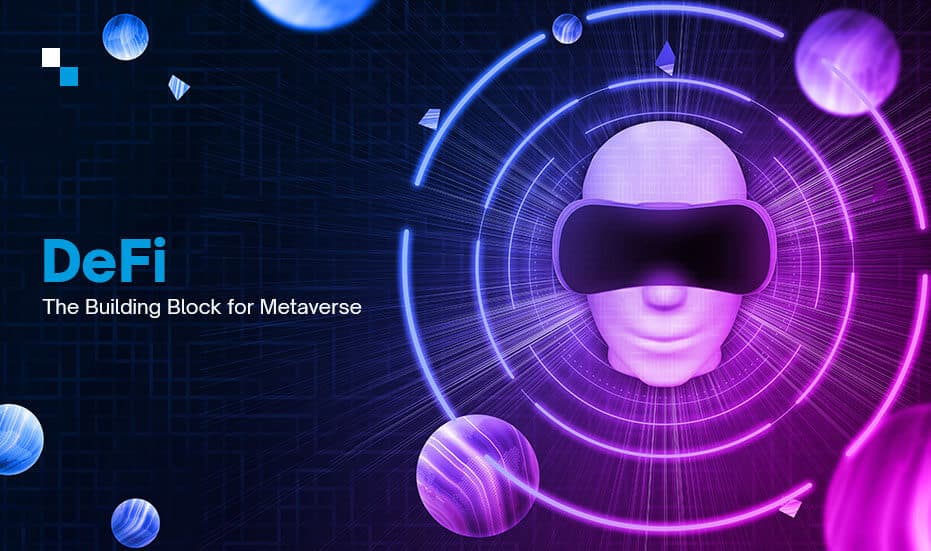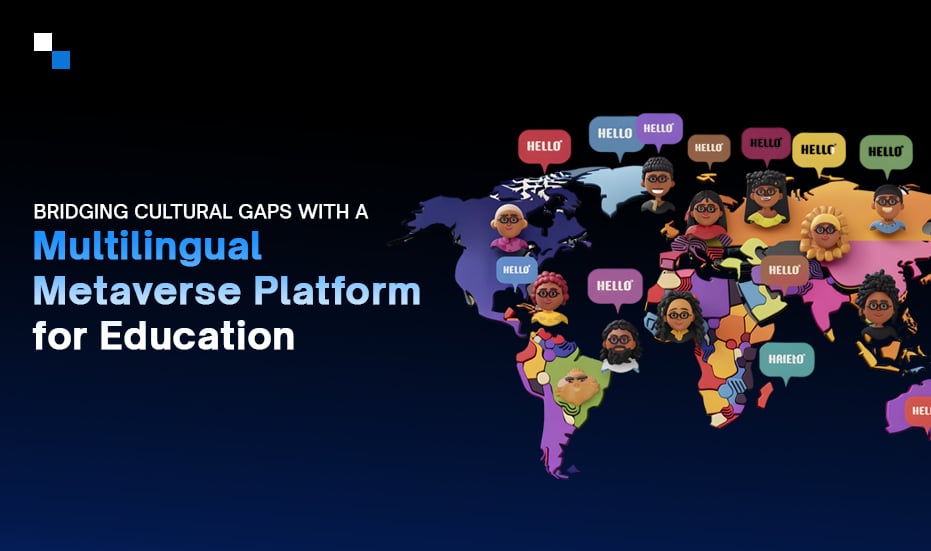
Crafting a State-of-the-Art P2P Crypto Exchange Software in 2024
May 16, 2022
Metaverse Development: Key Technologies Driving Change in 2022
May 17, 2022Metaverse is almost here and while the developments around it are in the nascent stages, this space is getting more and more exciting in the wake of rising crypto enthusiasm.Metaverse development, which earlier was driven by Virtual Reality (VR) and Augmented Reality (AR), is now all set to transcend into the crypto space. Recent trends have seen unprecedented changes in the virtual reality space as blockchain, decentralized finance (DeFi) and non-fungible tokens (NFTs) are all coming together to leverage the Metaverse space which is being seen as a newly found pot of gold.
Metaverse in all its glory is not at all complicated and offers an immersive, scalable and interoperable digital 3D virtual experience around an environment related to recreational activities like playing, working, socializing or shopping. This space has been transforming in a big way, inducing never-before levels of entertainment and engagement. The initial fears looming around navigating this new frontier are fading away and this technology is finding new applications beyond gaming and entertainment.
Emerging Trends:
Believing in the power of the Metaverse, big guns like Facebook and Microsoft have started to explore this space; Microsoft is thinking in terms of work, while Facebook is keeping it more about social media. With entertainment and gaming companies leading the way, there is a flux across many corners of the business world to converge with Metaverse technologies, and Metaverse developers are banking on building next-generation virtual spaces to create new streams of revenue. Let us try to understand why businesses are flocking to the Metaverse.
The virtual gaming industry has come a long way and the disruptors in this space like Roblox, Grand Theft Auto and Epic’s Fortnite have taken this experience to the next level where players take on avatars, and dive into the world of virtual adventures and carry a virtual identity. This has led to a whole new market for in-game purchases of outfits, makeovers, character upgrades, weapons, and accessories. This unprecedented digital immersion has taken over the Metaverse gaming industry by storm creating a new marketplace having huge revenue potential. Hugely successful ‘play and earn’ business model is being leveraged to create revenue streams and make the platforms more engaging for the users. This has been a great success so far.
Leveraging NFTs:Converging physical and digital worlds through NFTs is a trend that has invaded the Metaverse space and is giving rise to the digital ownership economy. NFT Metaverses are being pursued very enthusiastically by the users. Social interaction which used to be the core of these gaming platforms is history now. The new virtual reality enthusiasts are keen to become a part of this new economy where one can build virtual structures, own properties and exchange goods and services. To facilitate digital ownership, NFTs also started to become a part of these platforms where the inhabitants of such communities can purchase an original piece of art, a limited-edition Dolce & Gabbana collection or a Louis Vuitton handbag, all tokenized as digital assets, to establish and enhance their virtual identities. Owning prime properties on these platforms is the new craze and real estate in virtual worlds are going for millions of dollars. Recently someone paid $450,000 to be Snoop Dogg’s neighbor in a virtual world called the Sandbox, a popular Metaverse gaming platform.
Marketing on Metaverses:Luxury brands are also betting high on this space. They have also started to dig into Metaverse platforms to find new marketplaces as they are looking to meet consumers where they are spending their time and these Metaverses are very popular among their target customers. These brands release their products in limited quantities on this gaming Metaverse and users who purchase them receive an NFT as a virtual certification of ownership.
Gucci, a high-end fashion brand, has recently collaborated with Roblox, a gaming platform to host the Gucci Garden, a two-week art installation aimed at the brand building where players were seen with their avatars sporting Gucci handbags, sunglasses or hats. Gucci launched limited-edition digital-only fashion items. Similarly, Balenciaga, a popular luxury fashion brand, has also ventured into the metaverse and became the first to take on Fortnite enabling players to purchase digital outfits inspired by real-life Balenciaga pieces from its virtual boutique. These big-name fashion collaborations are marking the emergence of a new landscape that could unlock a huge multi-billion market.
MetaFi:This space has already started to look for ways to have a fully-functional economy and DeFi development for Metaverses is picking up the pace. And it is not surprising that crypto, blockchain, NFTs, DeFi, and DAO are being seen as building blocks for a reliable and and integrated Metaverse-ecosystem. Building and scaling a metaverse is not possible without a strong financial ecosystem capable of offering secure, seamless and interoperable functionalities around financial transactions happening on these platforms. This parallel economy needs a robust financial nervous system based on tokenization and governed by Decentralized Autonomous Organization (DAO) principles.
Decentralnad: A Metaverse Economy in Making
The industry has already seen great successful Metaverses which changed the face of this space with DeFi at the core. One such hugely successful frontrunner is Decentraland which is a virtual reality platform powered by the Ethereum (ETH) blockchain(https://decentraland.org/). Launched in 2017, the platform opened to public users in 2020. The platform uses the Ethereum blockchain to store and maintain ownership records. The whole platform is based on smart contracts which are coded automated agreements and are used to validate every transaction happening on Decentraland.
Its protocol which has decentralization at its core consists of three layers, namely Consensus Layer, Content Distribution Layer and Real-time Layer. Let us understand how these layers help in making Decentraland a truly decentralized platform.
Consensus Layer tracks the land ownership and its content using an Ethereum smart contract. On the Content Distribution Layer, this platform uses a decentralized storage system to distribute the content needed to render the world which allows the platform to work without the need for any centralized server infrastructure. The ecosystem in Decentraland exists in the most democratized manner where users themselves are responsible for distributing content, and the cost of running the system is shared with the same actors that benefit from it. Decentralization is prevalent at the third layer like all the communication among users takes place by establishing peer-to-peer connections with the help of servers hosted by landowners or third parties. Even the applications that the landowner wants to run inside the parcel are based on peer-to-peer connections which need no mediation.
As a DAO, Decentraland gives its community the power to participate in the overall governance of the project which they can exercise through their voting rights and these voting rights are proportional to the ownership of MANA, a native utility token of Decentraland. MANA token is also used as a currency within the virtual world to purchase goods, services, and land. Another important component of Decentraland is LAND which is a non-fungible token that represents the plots of land owned by players in the community and like MANA, it also provides voting power as part of Decentraland’s governance protocol.
The community of Decentraland inhabitants controls the land, digital assets, and developments of the platform. There is no single agent or a corporate entity with the decision-making power as every rule related to the software, contents of land, the currency, or access to the world are regulated through an open-source code. Decentraland has placed itself very strongly in the DeFi space and it has a strong foothold to leverage its position further.
Develop your own DeFi Platform with Us
Schedule Free DemoSandbox: A Successful Case of ‘Play & Earn’ Business Model
Another such blockchain-based decentralized virtual gaming platform is The Sandbox . It is an Ethereum-based metaverse that presents a decentralized gaming ecosystem allowing users to create, share, and monetize in-game assets and experiences through blockchain technology in a decentralized environment.
The Sandbox, which is based on user-generated content (UGC), consists of three integrated products namely VoxEdit, Sandbox Marketplace and Sandbox Game Maker and together these provide a comprehensive gaming experience allowing users to claim copyrights for their content through blockchain and smart contracts. Users can use VoxEdit that allows the users to create, rig, and animate their own voxel-based NFTs which they can sell on the Sandbox NFTs marketplace. These creations are stored on the IPFS network which provides decentralized storage and later after registration onto the blockchain these creations become ASSETS with definite ownership which can be sold on the NFT marketplace.
All transactions on The Sandbox use SAND which is a native utility token and is the basis for transactions and interactions. It is an ERC-20 utility token built on the Ethereum blockchain which is an open-ended decentralized software platform eliminating the need for a central server for hosting the data and transactions and this makes it a truly decentralized platform.
SAND is also a governance token that allows holders to participate in governance decisions on this platform as The Sandbox like Decentraland is using a DAO structure. SAND is used as a voting mechanism where 100% ownership is in the hands of the players. As the transactions in these virtual spaces have skyrocketed; digital lands and other NFT based assets are selling for millions in these virtual worlds and it is becoming a multibillion-dollar economy (https://www.cnbc.com/2022/02/01/metaverse-real-estate-sales-top-500-million-metametric-solutions-says.html).This huge market certainly needs a financial system which can support crypto and can offer a reliable and trustless environment.
Conclusion
Just like a physical world, Metaverses are keen to develop comprehensive and reliable financial ecosystems based on financial services like trading, credit, mortgages and rental agreements.
With NFTs already taking the center stage, DeFi is eventually finding its way into the virtual reality world giving users the control of trading and digital assets. As Metaverses are coming up with innovative and futuristic ‘play and earn’ business models, it would need a reliable and trustless financial ecosystem to support such a business model. While this sense of digital presence finds more and more space in modern societies, these virtual platforms are going to see high levels of financial transactions to build, own and rent digital assets and all this needs a truly decentralized, reliable and trustless ecosystem. It is only a matter of time before we see the full integration of decentralized finance into the Metaverse space.
At Antier Solutions, we offer comprehensive DeFi and metaverse development services to help businesses tap into the DeFi space. Our blockchain engineers and domain experts create a coherent roadmap to navigate your development journey.
Connect with our subject matter experts to share your needs for metaverse and DeFi development.



